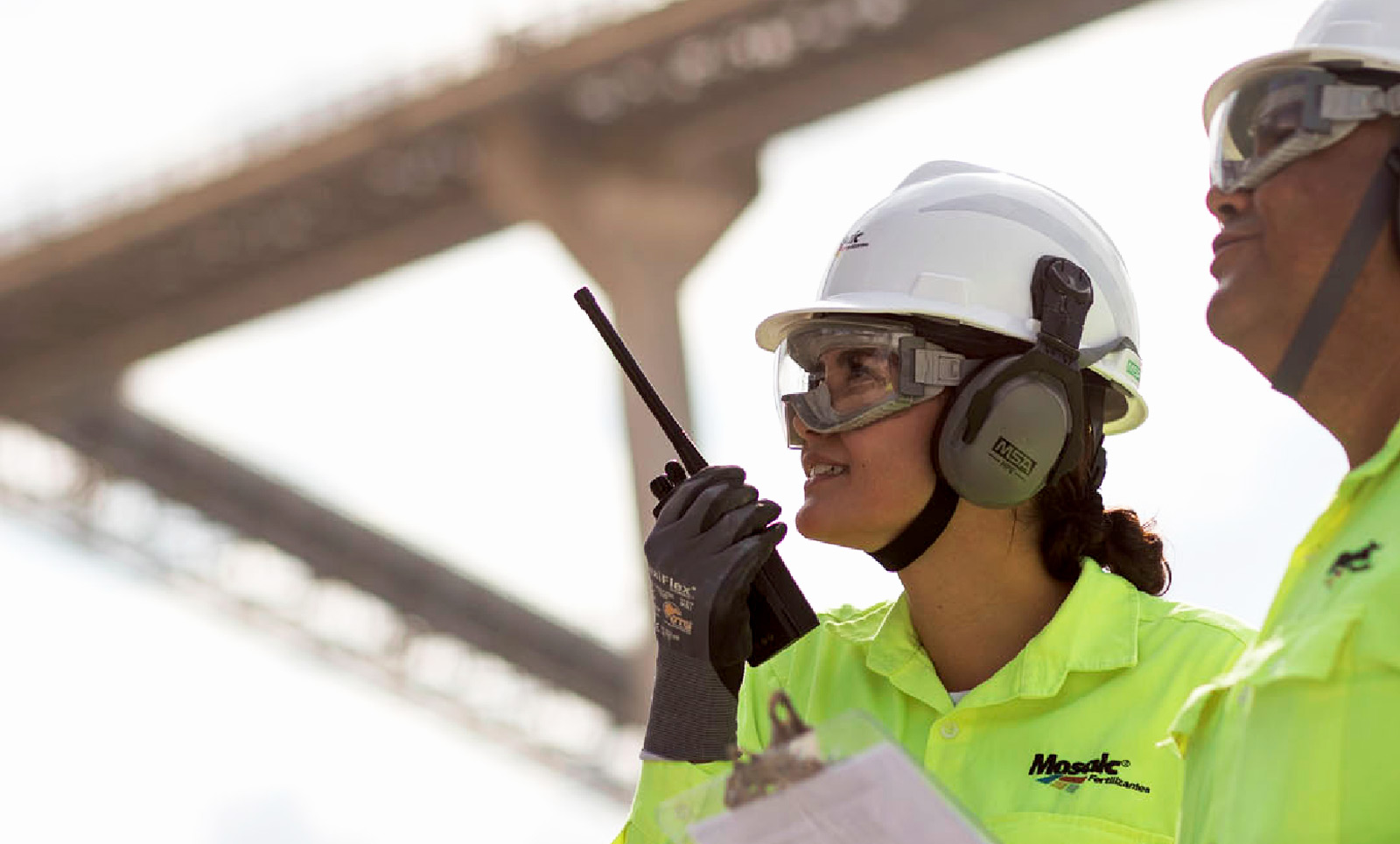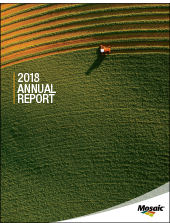PERFORMANCE
HIGHLIGHTS
2018 State of the business report
2018 HIGHLIGHTS
*Includes acquisition of Vale Fertilizantes on January 8, 2018.
**Phosphate cash conversion costs are reflective of actual costs, excluding realized mark-to-market gains and losses. These costs are captured in inventory and are not necessarily reflective of costs included in costs of goods sold for the period.
***MOP cash costs including brine management costs and royalties, excluding taxes and realized derivative gains/(losses). These costs are captured in inventory and are not necessarily reflective of costs included in costs of goods sold for the period.
“Our external recognition—including our first year on FTSE4Good Index and our ninth consecutive year on the Corporate Responsibility Magazine’s 100 Best Corporate Citizens list—validates our commitment to responsible operation.”
Joc O’Rourke – President & CEO
| 2014 | 2015 | 2016 | 2017 | 2018 | |
|---|---|---|---|---|---|
| Mosaic | 4.59 | 4.86 | 4.76 | 4.85 | 4.52 |
NOTE: “Intensity” refers to the volume of water (m3) used in making a single metric tonne of product. Production includes all crop nutrients and animal feed ingredients produced in the calendar year. “Freshwater” is defined as groundwater and surface water withdrawals and excludes reclaimed water, brine, seawater and once-through cooling and process water withdrawn from the Mississippi River in Louisiana. In alignment with our sustainability targets and progress tracking, these totals do not include newly acquired facilities in our Mosaic Fertilizantes segment. We will report those figures in the second phase of our sustainability disclosure, set to launch mid-2019.
| 2014 | 2015 | 2016 | 2017 | 2018 | |
|---|---|---|---|---|---|
| Mosaic | 2.59 | 2.60 | 2.68 | 2.31 | 2.40 |
NOTE: Total energy includes electricity, fuels and energy from waste heat consumed by Mosaic operations, including mines, manufacturing plants, distribution facilities, offices, agricultural operations and our Streamsong Resort. In alignment with our sustainability targets and progress tracking, steam is excluded as a source of energy. These totals do not include newly acquired facilities in our Mosaic Fertilizantes segment. We will report those figures in the second phase of our sustainability disclosure, set to launch mid-2019.
| 2014 | 2015 | 2016 | 2017 | 2018 | |
|---|---|---|---|---|---|
| Mosaic | 0.26 | 0.26 | 0.26 | 0.22 | 0.23 |
NOTE: Direct emissions include Mosaic’s consumption of natural gas, diesel, other fuels, process-related activities, water treatment and refrigerants. Indirect emissions include electricity purchased from third-party utilities. These totals do not include newly acquired facilities in our Mosaic Fertilizantes segment. We will report those figures in the second phase of our sustainability disclosure, set to launch mid-2019.
| 2014 | 2015 | 2016 | 2017 | 2018 | |
|---|---|---|---|---|---|
| Mosaic | 5.80 | 6.22 | 6.49 | 6.31 | 6.48 |
NOTE: Figures represent virtually greenhouse gas emissions-free electricity produced internally by concentrates facilities in our Phosphates and Mosaic Fertilizantes business segments. This process of waste heat recovery, called cogeneration, allows several of our plants and mines to significantly reduce the amount of third-party electricity required from utilities.
2018 Sustainability Performance Highlights
improvement in RIFR
reduction in freshwater use
reduction in total energy use
Sustainability Targets
Focused on Improvement
Mosaic’s 2020 targets were released in 2015 as our first set of quantifiable sustainability targets to address safety and the environmental areas most relevant to our business and stakeholders. We are proud of the progress we have made and the efficiencies we have realized throughout our operations since their launch. Beyond quantifiable measures of success, a cultural shift has been set in motion, and this change in employee mindset and awareness will serve us for years to come.
Looking ahead, our current 2020 targets are no longer adequate long-term measures of our progress due to the 2018 acquisition of major mines and production facilities in Brazil. We are excited for the next phase of our sustainability journey, which will include updated targets that incorporate the performance and ambitions of those operations. The new commitments and targets, which will be broadly defined under an umbrella of environmental, social and governance performance, will address a spectrum of issues relevant to Mosaic and its diverse stakeholders.
In the meantime, here is our 2018 report—our last—on our progress toward Mosaic’s 2020 targets.

We produced a 70% decrease in recordable injury frequency rate since 2011.
| Target | 2018 Performance | Where We Are Today |
|---|---|---|
| By 2020, reduce recordable injury frequency rate (RIFR) to 0.60. | 0.50 RIFR, a 34% improvement from 2017 | In 2018 we delivered the best safety performance of Mosaic’s 15-year history—achieving a 34% reduction in RIFR since 2017 and 70% reduction since 2011. Companywide, our focus remains on proactive reduction of risks to our employees with an ultimate goal of “zero harm” to people and the environment. We are on track to achieve a 0.6 RIFR by 2020. |
| Target | 2018 Performance | Where We Are Today |
|---|---|---|
| By 2020, reduce freshwater use by 10% per tonne of finished product. | 4.52 m3 per tonne of finished product, an 8.9% reduction from 2012 baseline | In 2018 our companywide freshwater performance rebounded from 2017 performance, and we are pleased to report a reduction of 8.9% from 2012 baseline levels. This year-over-year improvement is thanks to companywide initiatives; reductions in operational requirements, primarily at our Florida phosphate mining facilities; and ideal rainfall conditions. We are optimistic about meeting our original target of accomplishing a 10% reduction of freshwater use per tonne of finished product by 2020. |
| Target | 2018 Performance | Where We Are Today |
|---|---|---|
| By 2020, reduce total energy use by 10% per tonne of product. | 2.40 GJ per tonne of finished product, a 12.1% reduction from 2012 baseline | In line with expectations, our 2018 energy and GHG intensity rose slightly since 2017 due largely to our resuming normal ammonia production at our Faustina, Louisiana fertilizer production facility. This return to “normal” operating conditions and the resulting year-over-year increase were tempered by companywide efficiency projects and reductions in energy use in our Potash operations. Overall, we are still on track to meet our commitment to reducing energy use and GHGs per tonne of finished product by 2020. |
| By 2020, reduce our combined Scope 1 (direct emissions) and Scope 2 (purchased electricity) GHG emissions by 10% per tonne of product. | 0.23 tonnes CO2e per tonne of finished product, a 13.9% reduction from 2012 baseline |
